
Back in 2008 it was easy for me to find my camera in Nikon's lineup. In that time the D700 was both a fast and a high-resolution camera. It was the most expensive camera body I had ever bought until then. But it was a very good investment - I've used the D700 as my main body for nearly six years. Four years ago I bought a second sample of this versatile camera.
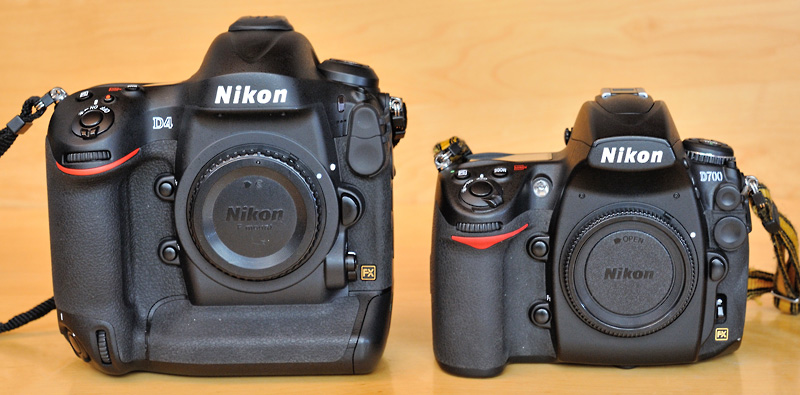
|
|
Size comparison. |
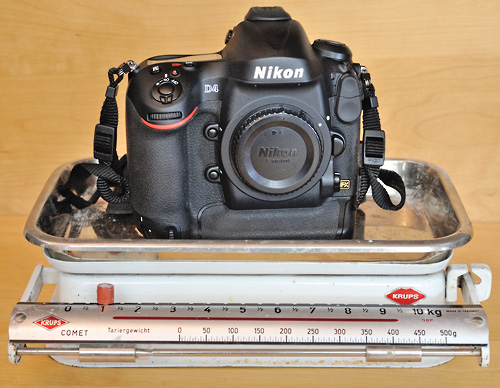
|
|
The D4 weighs 1400g including battery and memory card. |
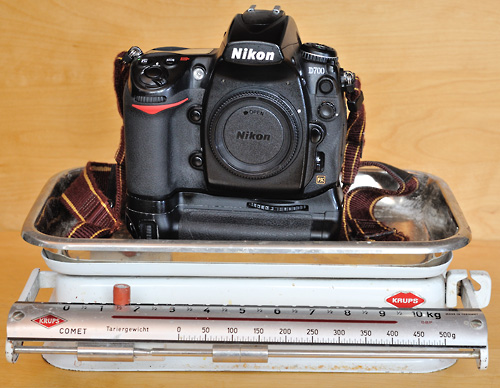
|
|
The speed-version of the D700 weighs 230g more! Memory card, 8 AA size cells and a EN-EL3 as a backup battery is included. |
For about 60% of my work I have used the body without the additional MB-D10. Whenever I really needed speed (about 10% of my work) I have used AA size batteries for the MB-D10. Of course, I had thought about buying D3 batteries. But the price for two batteries, the charger and two BL-3 chamber covers would have been about 400 €. A package of 8 AA size cells costs less than 2 €.
But speed is not only the number of frames per second, where the D700 shines. The size of the buffer also plays a very important rule. And the buffer of the D700 is full after 13 shots at maximum speed (losslessly compressed 14-bit raw files, SanDisk Extreme 32GB).
60x40cm prints from the D700 look fine. I haven't needed larger prints, yet. Nevertheless, sometimes I would like more pixels for getting more reach (by taking crops). I have tried the D300 that offers 12MP versus the 5.3MP of the D700's DX-crop. But the D300 slows down completely when shooting 14-bit raws. The upgraded D300s has the same problem (not to understand for me!). I have also tried our family's camera, the D5100. Image quality is really fine, especially in conjunction with my TC-14EII plus AF-S 300 f/4 combo. My main problem with using the D5100 for such applications is the autofocus system. I haven't tried the D7100 yet. This camera has got the 51-point autofocus system from the D4/D800 and it is surprisingly cheap. But it seems to have a serious buffer problem!
In 2012 Nikon announced the next pro/semipro generation: D4 plus D800. The D4 is a speed camera and a worthy successor of the D3/D3s. Although some people are still waiting for a D400, I think the D800 is both the successor of the D300 and of the D700. It is a great camera, but I am missing a speed option. Nevertheless I thought about buying one as an additional body. But the price for the body, the MB-D12, the new batteries and the necessary new memory cards kept me from doing that. On the other hand, the D4 was simply too expensive for me as an amateur photographer. Because of this dilemma and despite the improvements in sensor technology the D700 stayed my main camera for two more years. A Nikon D800h or so with the D4 sensor would have made everything clear for me! I guess, some professionals have the reversed problem: they miss a D4x (the D3x still is in Nikon's lineup!). Instead of a D800h or a D4x Nikon introduced the silly, slow and expensive Df. I'm really disappointed by Nikon's current model policies.
As a result of the D4s announcement in January 2014, a lot of D4 cameras came onto the second-hand market. I took the chance and bought one in like-new condition with less than 10000 shots for a reasonable price. I hope it will be the main solution for me for the next years, in terms of budget it must be...
I guess there are other D700 shooters with similar problems. In this article I will try to describe my experiences with the D4 from a D700 point of view. These are my first impressions after a few thousand shots. If necessary, I will update this article. I won't compare specs here, because I guess you know them!
Between the two sensors there are four and a half years. How pronounced are the differences in terms of image quality?
I put my AF-S 300mm f/4 (one of my sharpest lenses) onto a tripod and shot the same subject with both cameras at different ISO values within a few minutes. It was a sunny day with blue sky. Thus, the lighting conditions were the same for all images.
Here are the two images I shot with ISO1600, shown first at 50%, then at 100%. The images were raw converted with Nikon Capture NX2 and the D4-image was downpixelled to 12 MP with Adobe PSE.
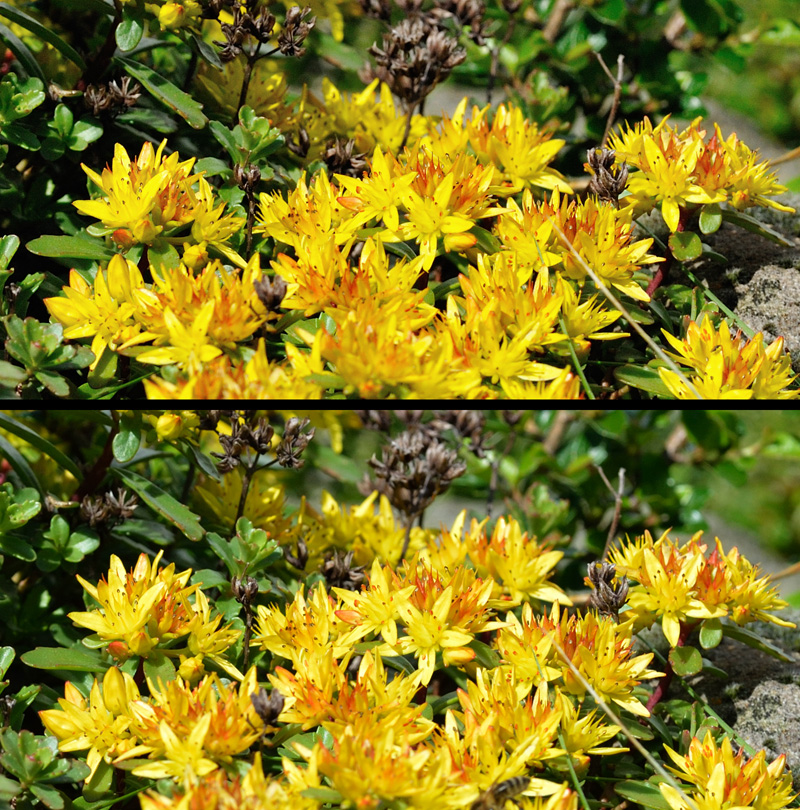
|
|
ISO1600, 50% crop, above the D700, below the D4 (downpixelled to 12MP). |
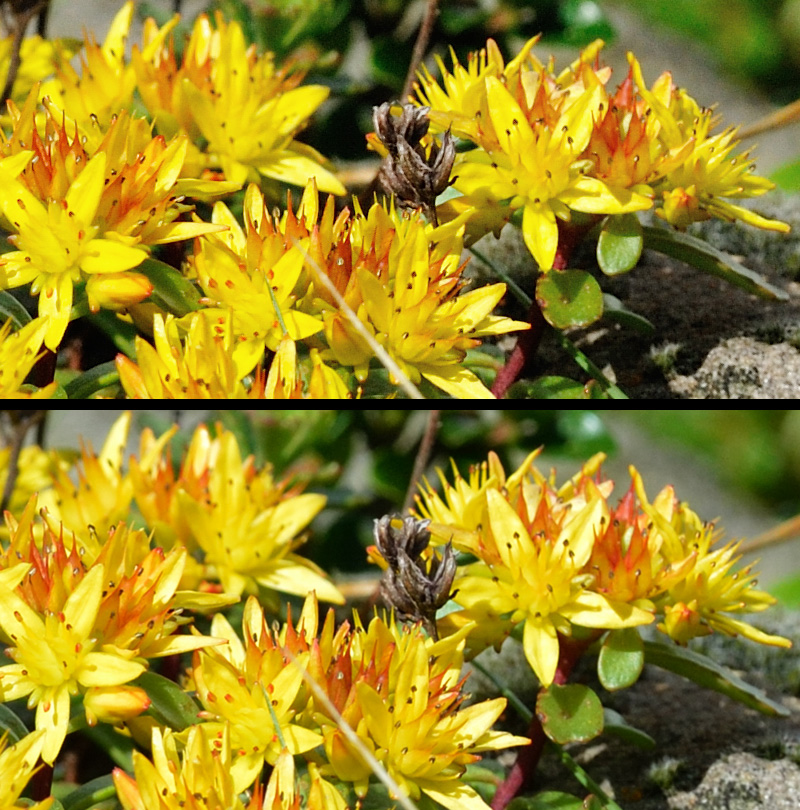
|
|
ISO1600, 100% crop, above the D700, below the D4 (downpixelled to 12MP). |
Firstly, the image from the D4 shows more contrast, especially at the blossoms. I thought I had made an error, but the raw file from the D700 simply does not contain these contrasts! This effect is visible at every ISO setting I have tested (400 to 6400). Secondly, the D4 shows less noise. The noise level of the D4 at ISO1600 matches the noise level of the D700 at ISO800. At higher ISO values the difference is more pronounced, at lower ISO values it is less pronounced.
The improvement is clearly visible. But the D4 does not declassify the D700. For me that means: I can use my D700 further on (as my second body).
Does the slightly higher pixel density have an impact on the performance of my lenses? On first sight I would say no! My lenses that I currently use intensively perform very well on the D4 (as well as they do on the D700):
The 16MP sensor gives a bit more reach which is very useful sometimes. The pixel width of the two cameras is 4256 vs 4928. Thus, taking a 12MP crop corresponds to an increasing of the focal length of about 16%. Looked at that way, my beloved combo TC-14II plus 300mm f/4 has a focal length of 487mm. That is not only theory, the performance even at 100% is very good (see sample images at the end of this article).
The D4 has two memory card slots: one for a CF card and one for an XQD card. Currently XQD cards are the fastest memory cards available. A Sony 64GB S-series XQD card costs around 330 € and a USB 3.0 XQD reader around 70 €. Due to my already strained budget I decided to use my CF cards at the moment ;)
So I took the SanDisk Extreme 32GB card out of the D700 and put it into the D4. I set the D4 to 10fps and shoot...
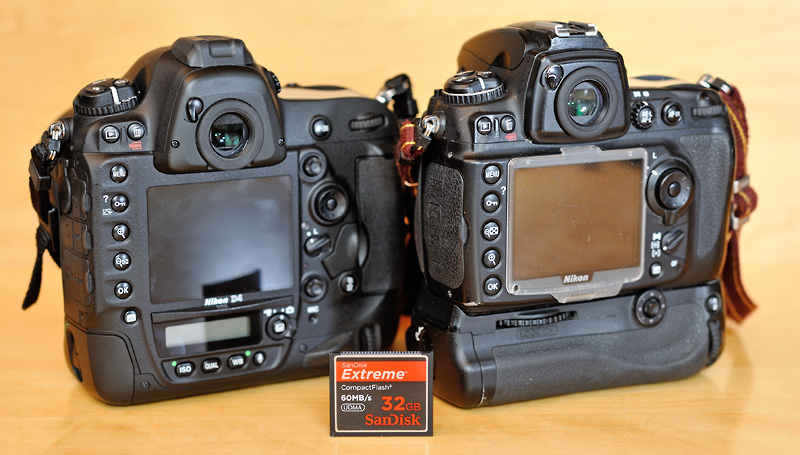
|
|
Do you need new memory cards for the D4 or can you use the cards from your D700? |
After 58 shots in losslessly compressed 14-bit raw mode the buffer was full and the D4 slowed down. I was really impressed! 58 16MP-shots at 10fps is a huge improvement over the 13 12MP-shots at 8fps of the D700. If the day should come when I say 58 shots is too slow for me, I will invest in XQD cards. After all I have read, more than 100 shots should be possible then before the buffer is full.
I was wrong here, see update below.
You will not have any problems to handle the D4! But if you plan to hold your D700 as a second body - as I do - you will have a few problems when changing the camera.
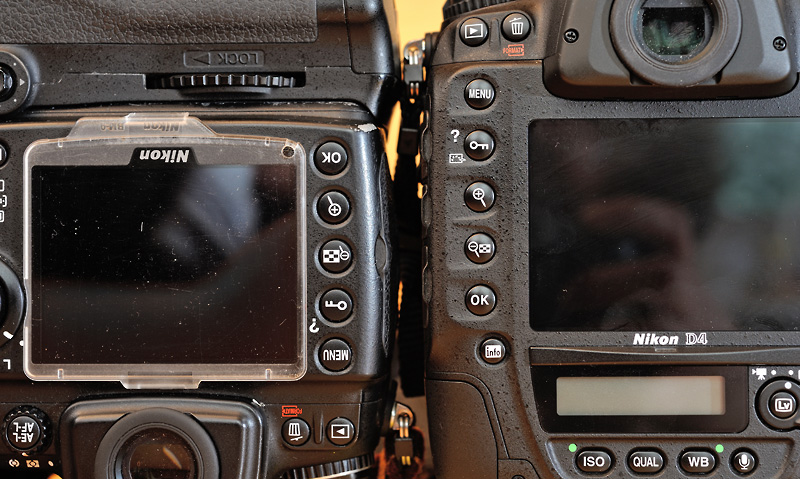
|
|
Nikon is well-known for the consistent ergonomics of their camera bodies. Here is an impressive example: on both cameras the zoom-in button is situated above the zoom-out button ;) |
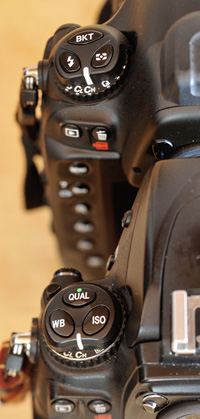
|
It was a crazy idea of Nikon's design department (or was it Giugiaro himself?) to reverse the positions of the zoom-in and zoom-out buttons. This is the most confusing issue between the two cameras and absolutely not to understand!
Another point is the three buttons of the former rewinding crank, see image to the right. On the D4 the WB, QUAL and ISO buttons are situated on the lower backside of the camera together with a dedicated, second display. I usually do not use automatic ISO, I set the values by hand. Thus I often need the ISO button. But it takes a while to find the button if you frequently switch between the two cameras! Do you have an idea why the D4 has two displays? I would like to find all the information I need on only one display (maybe one that is customisable for my needs)! Well, I guess I would soon accustom myself to the two-display solution if the D4 was my only camera. Maybe the professionals also are just accustomed to the two displays. They have known it since the days of the F5 and possibly they won't buy a camera without that second display ;)
While the D3, D700 and D800 have a dedicated metering selector, the D4 has a button on the rewinding crank you have to press while rotating the command dial. If you must change the camera, that is confusing, too.
The D700 has a dedicated AF-L/AE-L button (which is configurable in its functions). In addition to the multi selector the D4 has sub-selectors for both horizontal and vertical orientation. In the menus you can configure the function for pressing the sub-selector. One of the possible functions is the usage for AE-L and/or AF-L. In this case you have an AE-L/AF-L button for vertical orientation, too. But pressing this button must be done carefully, otherwise you might unintentionally switch to another focus sensor. Nevertheless, for me the D4 is preferable here.
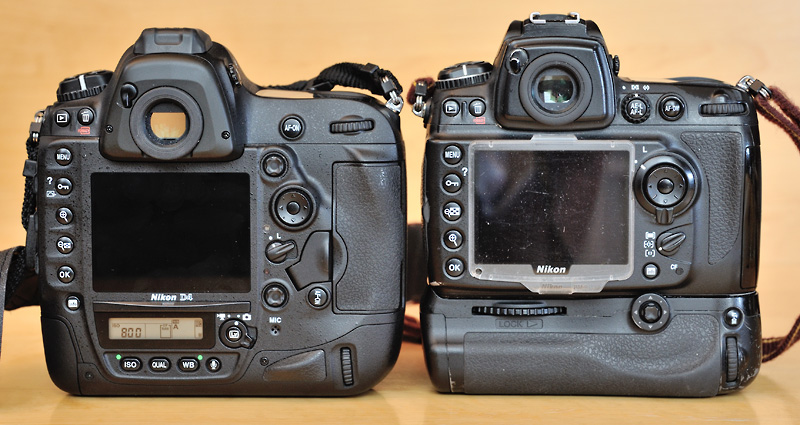
|
|
The backsides of the two cameras. |
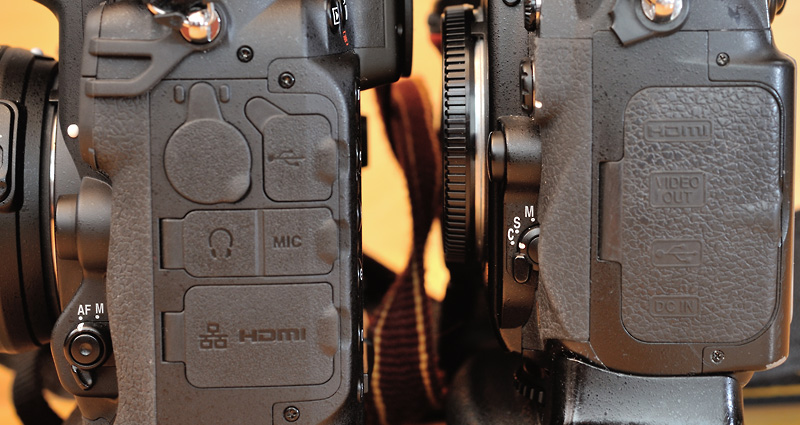
|
|
Comparison of the AF-M switches of the D4 and the D700. |
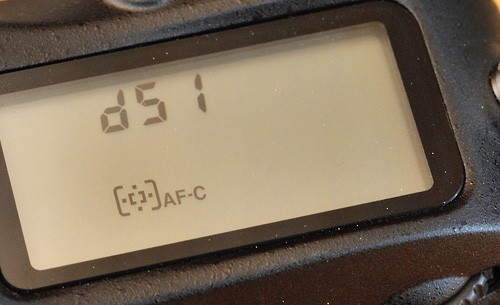
|
An often criticised point is that the D4 has neither a dedicated AF-S/AF-C switch nor a dedicated AF-area mode selector. The D4 has only an AF/M switch and an additional button on it. If you press the button (see image to the left, the viewfinder display shows the same information) you can select the AF-area mode with the front command dial and between AF-S and AF-C with the rear command dial. It is another confusing point between the D4 and the D700, but in my opinion the D4 method is better here. You can make these settings while looking through the finder!
It is possible to use the two bodies alternately. As described above, there are some problems, but overall I would rate them as minor. On its own, the D4 is the better camera in terms of ergonomics.
As mentioned above the D4 delivers a better image quality, has a better noise performance, is much faster and has overall the better ergonomics.
Moreover I would name these advantages:
Two years ago, when I wrote my article about remote controlling I was very enthusiastic about the D4's built-in web server. Connect the camera to your LAN and you just have to key in the IP address of the D4 into your browser to get remote control access (including live view):
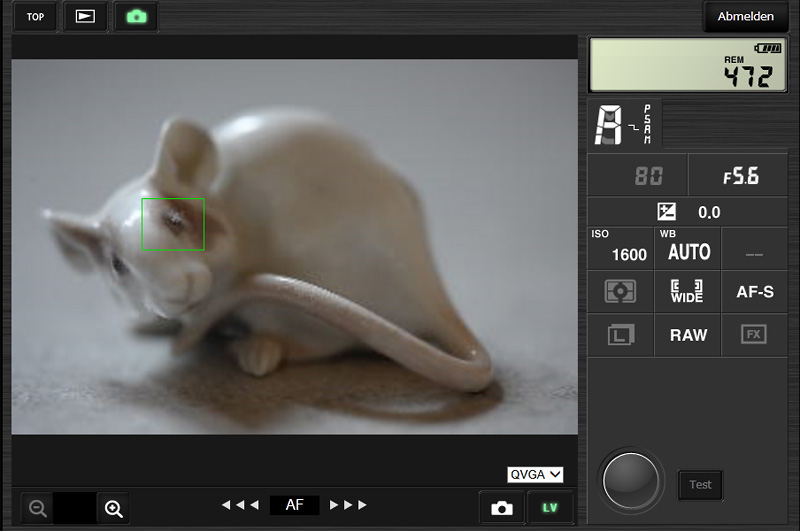
|
|
Remote access to the D4 via LAN, here shown in live view mode. |
With a mouse of porcelain that works really fine. But for shooting a living mouse this solution has a serious drawback: there is a significant time delay (about one second) between reality and the live view image on your computer. Nikon Camera Control Pro works much better here (connected to the D4 via USB)!
I compared the noise of the two cameras at 8 fps. The D4 appears a little bit quieter and the noise of the D700 consists of higher frequencies. Therefore the D4 sounds a bit more damped. Moreover, the D4 offers a quiet mode called 'Q'. I remember the 'CS' mode of the F4, which was really great compared to normal shooting, and had high expectations. But to my ears the 'Q' mode is only very slightly less noisy than the 'S' mode.
At last a word about the build quality and the materials used: I feel no difference between the two cameras. Of course, I expect the D4 to be better sealed, sturdier and more durable inside.
The D700 has two well-known advantages:
No need to say that you are less conspicuous with a small camera... For me the size of the D4 also leads to more technical restricions: it is not a camera for making extreme low angle shots and it is just too big for use in conjunction with my Nikon PB-4 bellows unit.
I have pretty much never used the D700's flash on its own. But I have often used it as the master flash within the CLS, mostly in conjunction with the SG-3IR. With the D4 that is only possible with an additional 250€ investment for the SU-800...
There is nothing to whine about the batteries of the D4. They perform very well! See update below.
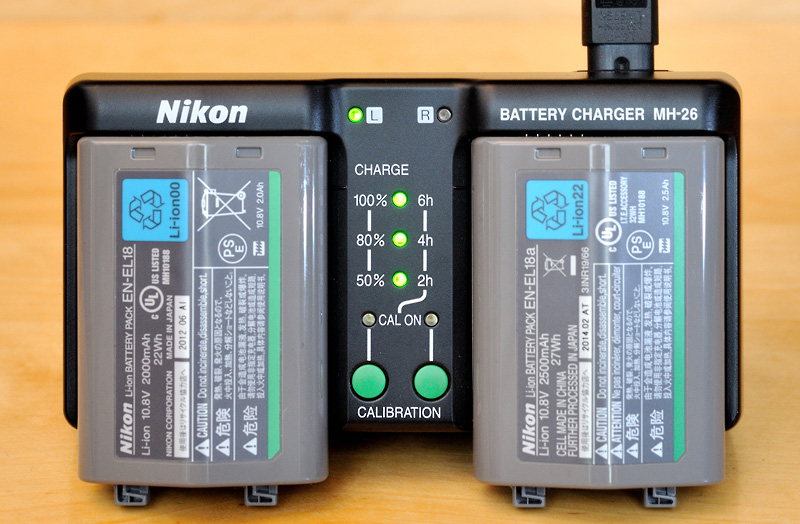
|
|
Together with the D4 there comes the EN-EL18 battery and the MH-26 charger. The MH-26 is able to charge two batteries successively. That is fine but on the other hand it takes a lot of space in your luggage if you go on a journey. As a second battery I bought an EN-EL18a (introduced with the D4s) that offers 25% more capacity. Two batteries are more than enough for me. |
Nikon made a hard cut in terms of batteries. The D800 uses a different kind of battery than the D700 does. Between the D4 and the D3 we have the same problem. Nikon is well known for the compatibility of their lens mount. But they were not able or unwilling to introduce new but backward compatible batteries. Moreover, while the D3 batteries are usable in the MB-D10, the EN-EL18 is not. A pity!
I am still satisfied with my decision for a used D4. Especially for telephoto photography the camera is very fast by all means. Up to ISO3200 the camera delivers top notch results, usable even at 100%.
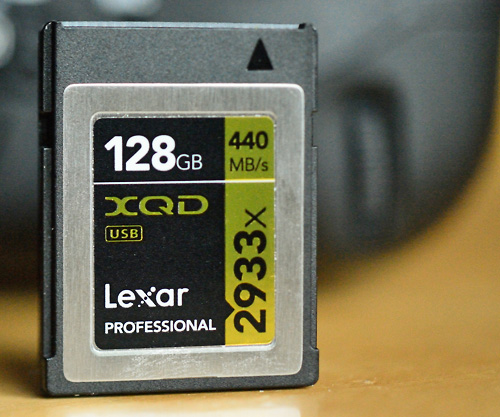
|
In March 2016, just before the introduction of the D5 and D500 Lexar reduced the price for their 2933x XQD cards by 50%. I seized the opportunity and bought a 128GB card. As Lexar published on their website, the 2933x card works without any problems in conjunction with the D4. With my CF cards (SanDisk Extreme) the buffer is full after 58 shots at 10fps (losslessly compressed 14-bit raw). With the new Lexar card I expected a significantly better performance. But the result was "only" 61 shots. I guess the 4-year old D4 is not fast enough here. Connected to my computer, the XQD card is much faster than my CF cards.
The battery performance of my EN-EL18a is simply stunning. In April I spent a few days on Heligoland and tested a rented 300mm f/2.8 Nikkor, see here. The 300mm was mounted on my D4 all the time, the VR was always on and the camera was set to AF-C mode. I shot 5500 images of birds and seals without recharging the battery (and without swapping the memory card as well)! Back home, the battery was still at 20% load.
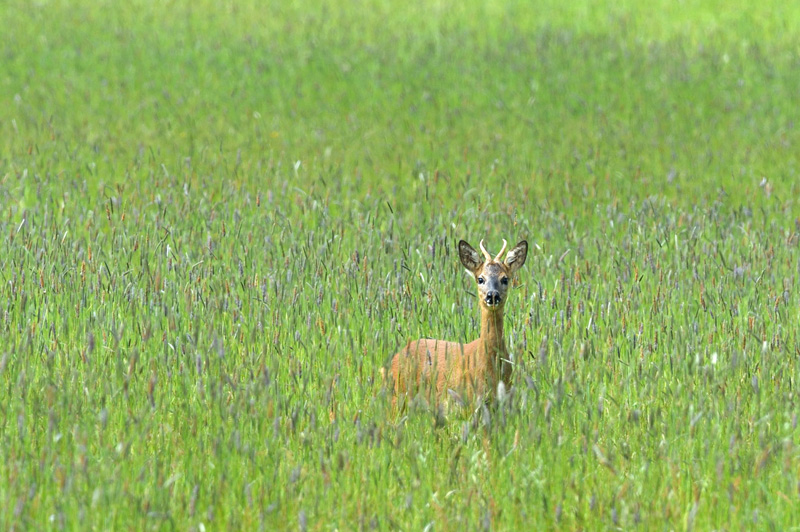
|
|
Deer in tall gras. ISO1000, 420mm (300mm + TC-14EII), F8, 1/1000 sec., hand-held. |
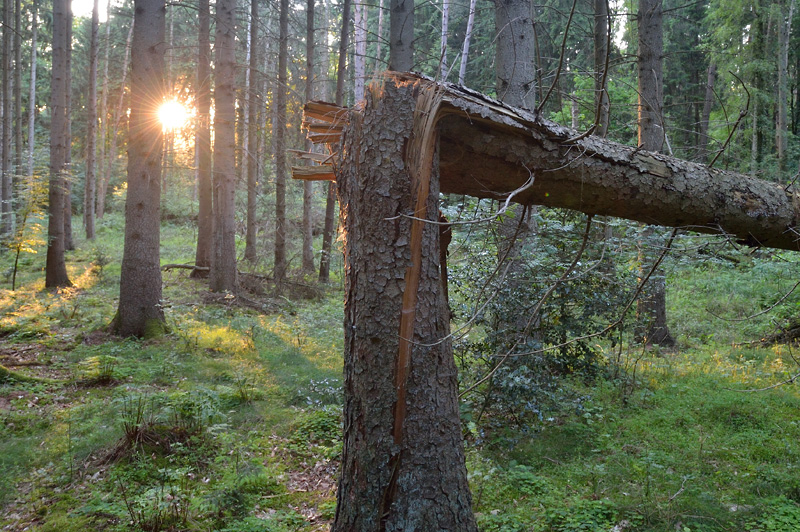
|
|
Snapped off. ISO1600, 17-35mm @20mm, F5.6, 1/50 sec. |
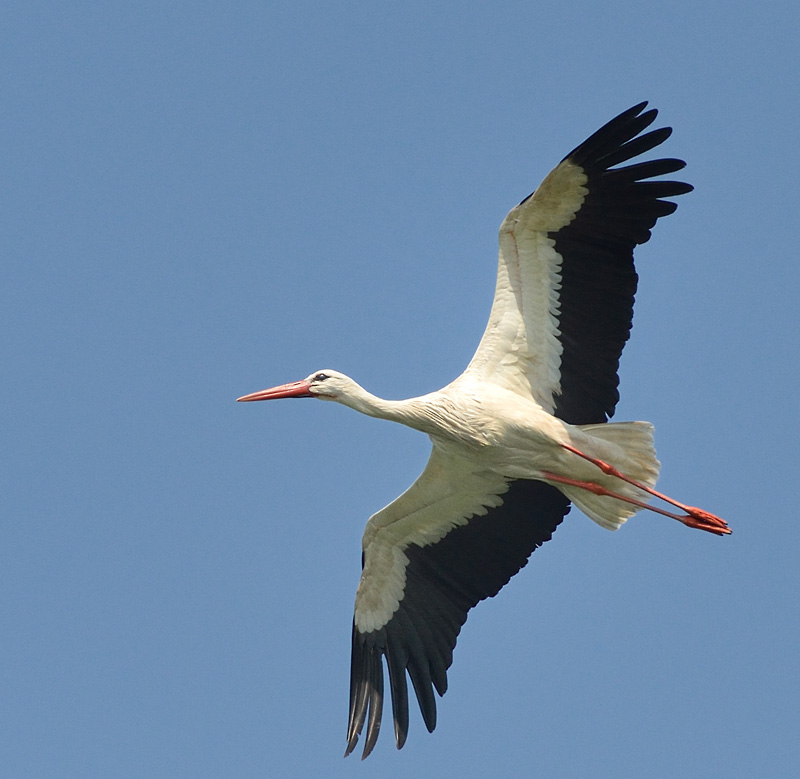
|
|
Flying stork. ISO1600, 420mm, F8, 1/6400 sec., hand-held. |
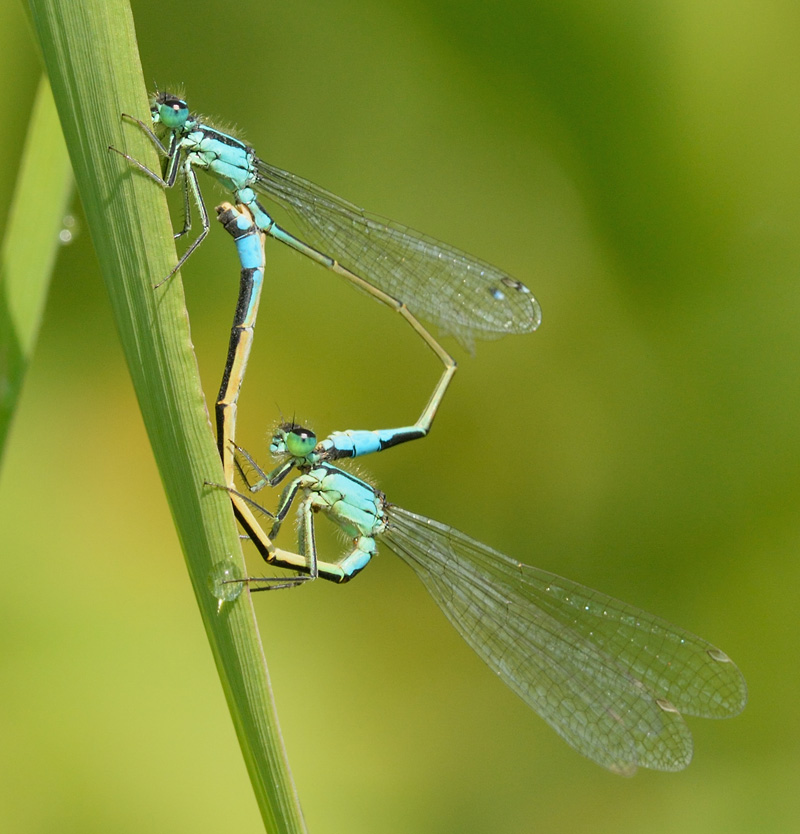
|
|
Procreation. 50% crop, ISO1600, 420mm, F11, 1/1600 sec., hand-held. |
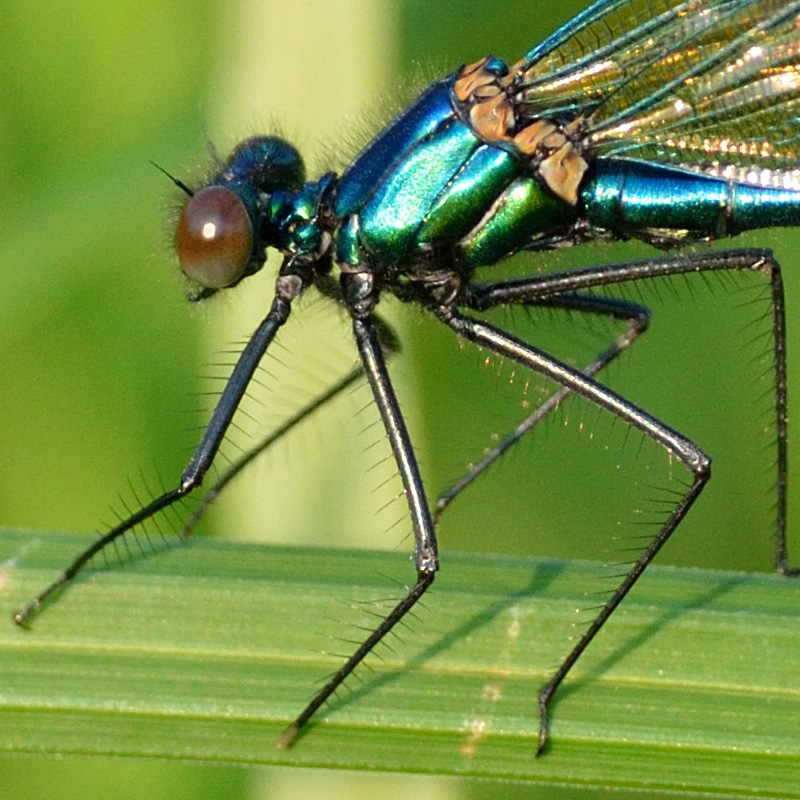
|
|
Banded Demoiselle. 100% crop, ISO2000, 420mm, F8, 1/1600 sec., hand-held. |
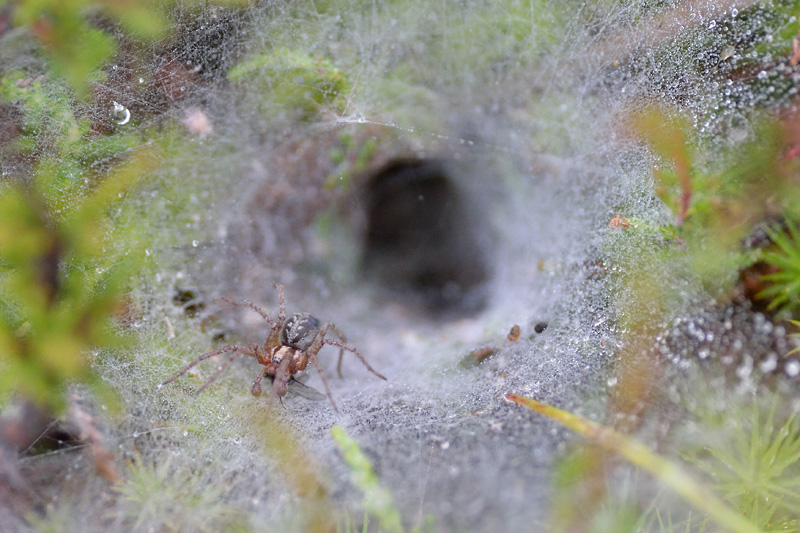
|
|
Breakfast in the front garden. ISO3200, 420mm, F5.6, 1/640 sec., hand-held. |
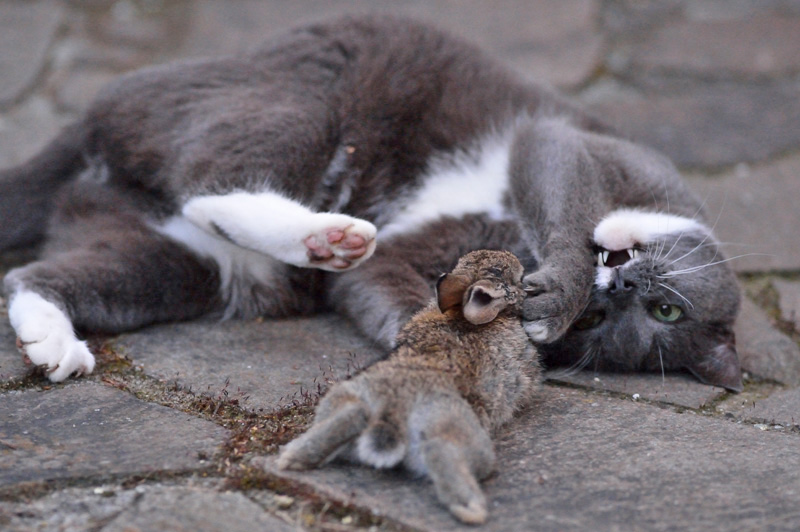
|
|
Playing between catching and eating. ISO12800, AF-Nikkor 180mm f/2.8, F4, 1/160sec., hand-held. |
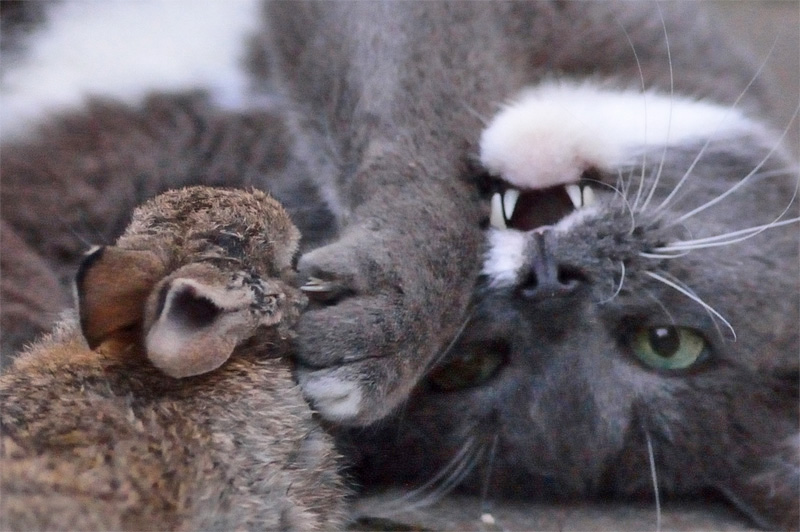
|
|
50% crop of the image above. |
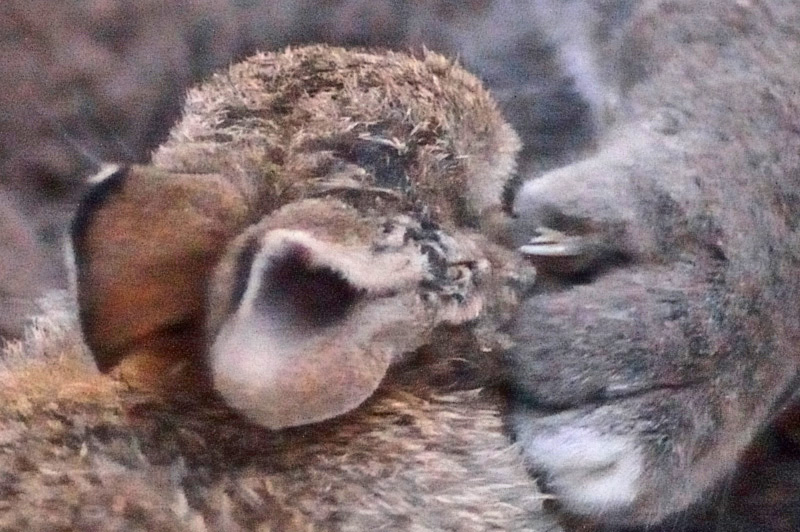
|
|
100% crop of the image above. |